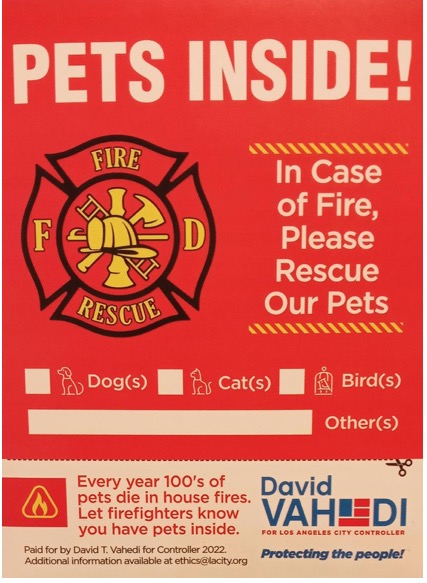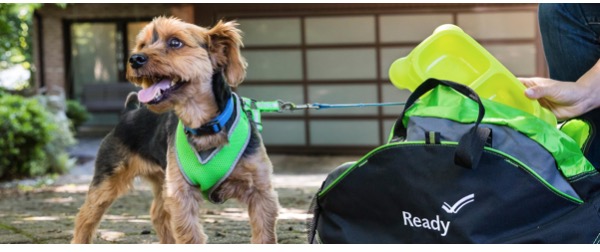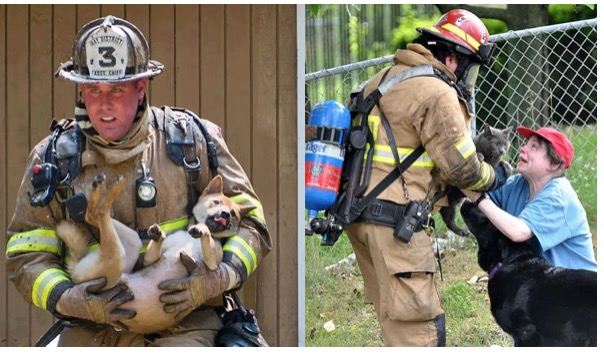CommentsANIMAL WATCH - Pets in Los Angeles and much of the U.S. find themselves living under much different conditions in 2022 than just a few decades ago.
An increasing number of young, unmarried adults choose a dog, cat or rabbit as a personal companion in an apartment, rather than waiting until they have a spouse, children and a house with a yard.
When David Vahedi, candidate for L.A. City Controller, recently called me and asked if I would like a “Pets Inside” sticker to notify responders of what creatures at my home would need rescue in a fire or other emergency situation, I realized how remiss I was in not replacing the one that peeled off from heat and old age a few years ago.

Also, the one he offers as a campaign gift can either be placed inside a window or affixed on the outside of the door (important in a multi-unit building) and has a blank space to enter pets’ names/special instruction.
As I looked out my window at the high-rise apartments that now surround our 19th century Echo Park home, and in view of the tragic multi-victim fires that have already begun to plague Los Angeles and surrounding areas this year, it was a reminder of how important it is that emergency responders (Fire Dept., LAPD, paramedics, L.A. Animal Services) know how many pets are living in these buildings with hundreds of units in the event of any disaster.
DO YOU HAVE A PLAN FOR EVACUATING YOUR PET(S)?
The American Kennel Club estimates that every year 500,000 pets in the U.S. are affected by house fires and approximately 40,000 of those die.
Equally sad, the American Veterinary Association says many of those left behind are not actually dead as a direct result of a fire, but are in need of oxygen and other veterinary care and are hiding. Many are just not found in time to save their lives, or the family has nowhere to go that will take their pet.
In the event you’re ordered to evacuate, you need an emergency plan in place that includes your cats, says Caster, which offers an evacuation plan for cats.
Also, see important article, “How to Get your Cat into a Pet Carrier“ by Jackson Galaxy and start practicing NOW.
Following, is some important advice (from many sources) that might help save the lives of our best friends who have no voice but ours to assure their safety, including tips on protecting horses or other outside animals.

THANKS, DAVID VAHEDI, FOR THINKING OF PETS
Deepest thanks to David “Ty” Vahedi for using campaign money on this positive and practical way to introduce himself to voters and to remind us we need a plan in advance to save our animals’ lives.
The Vahedi’s have two “rescued” dogs and also two school-age children, and he says the safety of everyone in his family—and others—is on his mind 24-hours a day, just like all parents in these critical times.
HIGH-RISE BUILDINGS POSE SPECIAL CHALLENGES – BUT ADVICE APPLIES TO ALL
Keep a sticker on your door and/or an accessible window to let responders know how many and what species of pets are present, their name(s) and add any important information on a note, such as, where they stay in the house, if a dog is protective or a cat has a special hiding place.
Put carrier(s) for small animals near the door and train your pet to enjoy entering by leaving small treats or favorite toys inside and making it a “safe” and comfortable place—rather than just the means of transport to a veterinarian.
Keep leashes hung just inside the entry door and include a soft lasso (slip) leash, such as used by veterinarians that can be easily slipped over your dog’s head without having a stranger touch its face.
Be sure your dog has a collar with tags to identify it and is wearing its license—even when indoors because we never know when disaster will strike. (Some cat owners are not comfortable with cat collars and rely on microchips.)
Attaching an ID tag on each leash can also be critical, in case the dog slips out of or isn’t wearing its collar. Some tag companies offer the service of having their number also on the tag and notifying you if your dog is reported found anywhere in the U.S.
SOCIALIZE YOUR PET
Any first-responder who enters a burning or damaged building to rescue an animal is a stranger but also a friend, so it is wise to anticipate that your pet’s life may depend upon how he/she reacts to humans and that could be key to its survival.
Socialize your pet so that it will welcome help and not automatically run and hide from a rescuer and will be more likely to respond if it hears its name and the call or command to come to the person.
If possible, keep pets confined in a main area near the front door to save valuable minutes or seconds that can make the difference between life and death. If that is not possible, have a sign immediately inside indicating where they stay in the house/apartment. However, also take precautions to ensure pets don’t escape when there isn’t a disaster. (This can be balancing act of location and confinement but is worth the effort.)
Although there are many of traditional rules for saving the life of your pet(s) in a fire, there are new ways in the age of electronics that can help.

MICROCHIP YOUR PET(S)
We tend to think only of dogs and cats when microchipping is discussed, but if it runs, hops, crawls, slithers or swims, there are various sizes of microchips that are available for almost all living creatures.
“Microchips can be fitted to horses, rabbits, guinea pigs, lizards, fish…in fact the list is endless!,” according to Prospect House Vets.
FEAR CAN BE A FATAL FACTOR FOR BUNNIES
Rabbits are the third most popular pet in Los Angeles, but they require experienced handling and can also inflict serious injury when they become frightened. Keep your rabbit’s carrier close to the door.
A touching story with photos on April 14, 2022, “Firefighters Save Pet Bunny from Apartment Blaze in Sydney,” by 9News(NSW), shows a fireman carrying out a large white bunny from an upstairs unit.
"We received information that there was a rabbit inside that was a much-loved pet of the resident," a firefighter told 9News as he came down from the unit with “Brian.” We stumbled across the rabbit hiding under the TV cabinet," he said.
This bunny had been lovingly handled by many family members and willingly accepted help. But many bunnies are not that fortunate. They are very likely easily alarmed and can die from a heart attack caused by loud noises, dogs, cats or any sudden stress, according to experts. (See: Preparing For Emergencies | The Rabbit Haven)
When removing any small animal (including cats) in a cage or other carrier/container, it is advisable to cover the carrier with a lightweight small blanket or towel to reduce stress.
Research specific emergency preparedness for any species ahead of time, so that items needed for safe transport are visible and accessible to responders.
If you have reptiles or aquatic pets, be sure you have a way to transport them in safe, secure containers and have an adequate food supply for them. Animal shelters can take in some animals but, during a disaster, we all have to be our own and our pets’ savior.
Be sure you have a planned destination where your pets can be safely kept.
KEEP CURRENT INFO, RECORDS, PET PHOTO
Post in visible location: “Instructions in case of emergency.” (A decorative chalkboard is ideal because information can be easily updated, but keep it short and specific.) Also, copy important info, photos to your phone.
Keep your dog or cat rabies vaccination up-to-date and have a copy of this information in an emergency evacuation packet near the door, along with any special veterinary instructions and pet medications. As in most places throughout California, dogs over four months of age are required to be licensed in the City of Los Angeles, and the rabies shot must be renewed every three years.
Cats are not licensed in the City of Los Angeles but should have a valid rabies and other vaccinations because they may be taken to a location where there are sick animals with contagious diseases. (Cats are required to be licensed in some other cities.)
IF YOUR PET GETS LOOSE
If your pet gets loose during an emergency, notify the closest shelter as soon as possible.
L.A. Animal Services advises finders of pets to keep them at their home, rather than bring them to the shelter, so be sure to inform the Department you are looking for your pet and transmit a current photo (take frequent photos as your pet ages.)
Be sure your dog/cat is wearing a tag which also shows the phone number of someone who does NOT live at the disaster location and could come and pick up the pet in case you and/or your phone is unreachable.
CREATE A “BUDDY SYSTEM”
Make friends with other pet lovers/owners nearby so there is someone familiar to your pet and might be able to immediately take it and let you know it is safe.
Go to “Ready.gov” for a complete list of essentials in preparation for any emergency, including having a photo of you with your pet available and all necessary items in your emergency kit.
Also make sure any children in the family are involved in planning and carrying out the family safety plan for all family members, including pets, in case of an emergency.
SAVING LARGE ANIMALS IN FIRE/DISASTERS
L.A. County Animal Care and Control provides excellent preparation advice for any emergency where horses or large animals are involved at “Are you and Your Horses Prepared for an Emergency Event?.”
In addition to the equipment necessary to safely care for and plan the transport of horses, it has such practical reminders as having your cell phone handy with a portable charger, and microchipping your horse. (The City of L.A. also licenses horses.)
Emergency responders say that often their biggest hurdle in saving horses is that the animal has apparently never been loaded for transport and/or is so fearful of entering the transport vehicle that it is dangerous to handle. Too many times there is then no alternative but to release the horse and hope it survives and is found.
See: Remembering LA on Fire -- Evacuating Pets with Two LAAS City Shelters Closed; and L.A. Pet and Horse Owners May be on Their Own in Fires or Disasters.
ARE YOU REALLY READY?
Saving lives in an emergency takes a village but its success starts long before the emergency occurs.
David Vahedi’s offer of a “Pets Inside!” door/window sticker is an important reminder for those who believe they are ready for a fire, earthquake or other disaster to review the items in their evacuation kit and assure it is current, such as, medications (human and veterinary) and pet food have not expired, and that the kit contains a charger for your current phone.
Assure your computer is automatically backed up at an off-site location, so that you do not lose valuable work product and priceless business/personal records.
Here’s the link for more information about David “Ty” Vahedi and his important campaign for Los Angeles City Controller and to get a “Pets Inside!” door/window sticker to help protect your best friends and “fur babies” in a fire or other disaster.
(Phyllis M. Daugherty is a contributor to CityWatch and a former Los Angeles City employee.)






